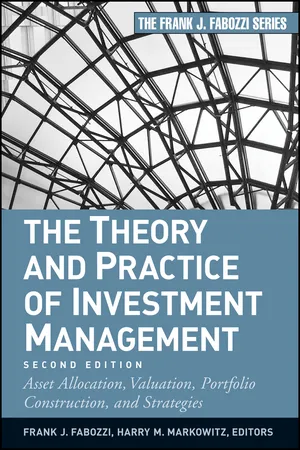![]()
PART One
Instruments, Asset Allocation, Portfolio Selection, and Asset Pricing
![]()
CHAPTER 1
Overview of Investment Management
Frank J. Fabozzi, Ph.D., CFA, CPA
Professor in the Practice of Finance
Yale School of Management
Harry M. Markowitz, Ph.D. Consultant
The purpose of this book is to describe the activities and investment vehicles associated with
investment management. Investment management—also referred to as
portfolio management and
money management—requires an understanding of:
• How investment objectives are determined.
• The investment vehicles in which an investor can allocate funds.
• The way investment products are valued so that an investor can assess whether or not a particular investment is fairly priced, underpriced, or overpriced.
• The investment strategies that can be employed by an investor to realize a specified investment objective.
• The best way to construct a portfolio, given an investment strategy.
• The techniques for evaluating performance.
In this book, the contributors explain each of these activities. In this introductory chapter, we set forth in general terms the
investment management process. This process involves the following five tasks:
1. Setting investment objectives.
2. Establishing an investment policy.
3. Selecting an investment strategy.
4. Constructing the portfolio.
5. Measuring and evaluating investment performance.
SETTING INVESTMENT OBJECTIVES
Setting investment objectives, begins with a thorough analysis of the investment objectives of the entity whose funds are being managed. These entities can be classified as individual investors and institutional investors. Within each of these broad classifications is a wide range of investment objectives.
Institutional investors include:
• Pension funds.
• Depository institutions (commercial banks, savings and loan associations, and credit unions).
• Insurance companies (life companies, property and casualty companies, and health companies).
• Regulated investment companies (mutual funds and closed-end funds).
• Endowments and foundations.
• Treasury department of corporations, municipal governments, and government agencies.
In general, we can classify institutional investors into two broad categories: those that must meet contractually specified liabilities and those that do not. We can classify those in the first category as institutions with “liability-driven objectives” and those in the second category as institutions with “nonliability driven objectives.” A liability is a cash outlay that must be made at a specific time to satisfy the contractual terms of an issued obligation. An institutional investor is concerned with both the amount and timing of liabilities because its assets must produce the cash flow to meet any payments it has promised to make in a timely way.
Some institutions have a wide range of investment products that they offer investors, some of which are liability driven and others that are nonliability driven. Once the investment objective is clearly defined, it will then be possible to (1) establish a “benchmark” by which to evaluate the performance of the investment manager and (2) evaluate alternative investment strategies to assess the potential for realizing the specified investment objective.
ESTABLISHING AN INVESTMENT POLICY
Establishing an investment policy starts with the asset allocation decision. That is, a decision must be made as to how the funds to be invested should be distributed among the major classes of assets.
Asset Classes
Throughout this book, we refer to certain categories of investment products as an “asset class.” In the next chapter, we take a closer look at what is meant by an asset class. From the perspective of a U.S. investor, the convention is to refer to the following as traditional asset classes: U.S. common stocks, non-U.S. (or foreign) common stocks, U.S. bonds, non-U.S. (or foreign) bonds, cash equivalents, and real estate. Common stock and bonds are further divided into different asset classes. Cash equivalents are defined as short-term debt obligations that have little price volatility. In addition to the traditional asset classes, there are asset classes commonly referred to as alternative assets or alternative investments. Two of the more popular ones are hedge funds and private equity. In the next chapter, we review three popular alternative assets.
Constraints
There are some institutional investors that make the asset allocation decision based purely on their understanding of the risk-return characteristics of the various asset classes and expected returns. The asset allocation will take into consideration any investment constraints or restrictions. Asset allocation models are commercially available for assisting those individuals responsible for making this decision.
In the development of an investment policy, the following factors must be considered: client constraints, regulatory constraints, and tax and accounting issues.
Examples of client-imposed constraints would be restrictions that specify the types of securities in which a manager may invest and concentration limits on how much or little may be invested in a particular asset class or in a particular issuer. When a benchmark is established, there may be a restriction as to the degree to which the manager may deviate from some key characteristics of that benchmark.
There are many types of regulatory constraints. These involve constraints on the asset classes that are permissible and concentration limits on investments. Moreover, in making the asset allocation decision, consideration must be given to any risk-based capital requirements. For depository institutions and insurance companies, the amount of statutory capital required is related to the quality of the assets in which the institution has invested.
Tax considerations are important for several reasons. First, certain institutional investors such as pension funds, endowments, and foundations are exempt from federal income taxation. Consequently, the assets in which they invest will not be those that are tax-advantaged investments. Second, there are tax factors that must be incorporated into the investment policy. For example, although a pension fund might be tax-exempt, there may be certain assets or the use of some investment vehicles in which it invests whose earnings may be taxed.
Generally accepted accounting principles (GAAP) and regulatory accounting principles (RAP) are important considerations in developing investment policies.
SELECTING A PORTFOLIO STRATEGY
The next task in the investment management process is selecting a portfolio strategy that is consistent with the investment objectives and investment policy guidelines. The selection can be made...
